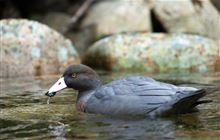Whio education resource in te reo for Taranaki schools
Archived content: This media release was accurate on the date of publication.
Introduction
A new resource in te reo Māori has been released by DOC in Taranaki. It looks closely at whio, the very special ducks that live on the rivers and streams of Mounga Taranaki.Date: 31 May 2018
Te Whio Mō Ake Tonu Atu was developed by Urenui’s Te Amoroa Clifton who said that this resource was from a Te Ao Māori world view incorporating Māori values, proverbs, stories and karakia. The Taranaki whio programme and stories are highlighted and the resource provides a useful link to Whio Forever, released last year by DOC and Whio Forever partners, Genesis Energy.
Genesis Chief Executive Marc England said it’s a significant milestone in the work being done to ensure this iconic bird is not forgotten. “By learning about the whio in te reo, New Zealand’s tamariki will be challenged to nurture and protect the whio and the many sacred species that coexist in its environment.”
DOC Community Supervisor Mike Tapp said Te Amoroa and the reviewing team have done a great job. “We hope this resource will be a handy tool for those teaching in a Māori medium and all teachers striving to introduce more te reo into their classroom programmes.”
Like the original Whio Forever resource, Te Whio Mō Ake Tonu Atu is available on this website:
Blue duck/whio fun facts posters
Background information
- The whio is a threatened species of native duck that is only found in New Zealand’s fast flowing waters. Featured on New Zealand’s $10 note and with an estimated nationwide population of less than 3,000 birds, whio are rarer than kiwi.
- Whio are adapted to live on fast-flowing rivers so finding whio means you will also find fresh, fast-flowing water with a good supply of plants and underwater insects.
- This makes whio important indicators of ecosystem health – they only exist where there is quality fresh water and an abundance of life.
Whio Forever
- Genesis has a strong historic association with whio through the Tongariro Power Scheme and in 2010 this association grew through the establishment of Whio Awareness Month (March). The dates of this month have now shifted to better reflect the whio release season of mid-March to mid-April.
- Today, Genesis and DOC continue their partnership through the Whio Forever Project, which aims to secure the future of whio in the wild and ensure New Zealanders understand and value whio in our rivers.
- The support of Genesis and the work of DOC has enabled the Whio Recovery Plan to be implemented.
Conservation issue
- Whio are predated by stoats, ferrets and cats with the largest impact during nesting time when eggs, young and females are vulnerable, and also when females are in moult and can’t fly.
- Extensive trapping can manage these predators and work in key whio habitats by DOC and Genesis on the Whio Forever Project has already seen an increase in whio numbers.
- Whio cannot be moved to predator-free islands like other species because of their reliance on fast-flowing rivers.
- Pairs occupy approximately 1 km of water – so they need a lot of river to sustain a large population and they fiercely defend their territories, which makes it difficult to put them with other ducks in captivity.
- Whio are susceptible to flood events which, destroy nests, fragment broods and wash away their valued food source.
Contact
For media queries contact:
Mike Tapp, DOC Supervisor Community
Mobile: +64 27 447 7229
Email: mtapp@doc.govt.nz

